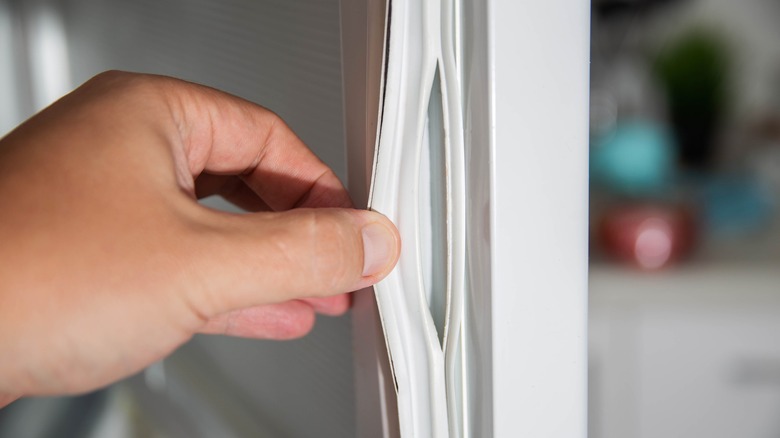Cleaning This Part Of Your Fridge Is More Important Than You Probably Realized
Smelly odors and unsightly food stains are usually our indications to put some elbow grease into the refrigerator. As you clean, you're likely wiping the shelves and pulling out the drawers; a wild hair may even prompt you to tackle the exterior, cleaning above, behind, and below the appliance. In that whirlwind of soaping and scrubbing, though, you could be missing an area whose maintenance is critical to a properly functioning fridge: the gasket.
A refrigerator gasket, also known simply as the door seal, locks in cold air you're paying good money to produce. They're typically made of rubber or PVC, two materials that are susceptible to mold and a general build-up of food molecules like fats and sugars. If left uncleaned, that mold and food build-up can cause the gasket to harden.
Once a gasket hardens, it becomes much easier for the rubber or PVC to crack and weaken as you open and close the door. Over time, it will lose its ability to properly seal. A weak seal will allow warmer air to seep into the fridge or freezer, increasing the internal temperature. The appliance will run more in an attempt to combat this intrusion, inevitably raising your electricity bill, but the extra charge could all be for naught. The food inside is likely to spoil as a result of the warm air battle, sending even more money out the door.
Cleaning and maintaining a refrigerator gasket
The best way to maintain a proper seal on your refrigerator is to clean the gasket regularly. Simply wipe it thoroughly with a little soap and a wet sponge, paying close attention to the folds of the seal as mold is particularly fond of those areas. A cotton swab will work wonders if the sponge can't reach all the crevices. If you spill anything on the gasket, you'll want to clean it immediately. Food gunk, especially the sticky kind, can cause the seal to get pulled out of place.
One thing to avoid during this cleaning process is bleach. While it's certainly a mold killer, the harsh chemical can also be a plastic killer. If you use enough of it, the gasket will dry out, leading to the same cracks and weakness. Two alternatives are watered-down hydrogen peroxide or a combination of baking soda and water. Once the clean gasket dries, apply a thin layer of petroleum jelly to lubricate and hydrate it.
If you're worried about the strength of the door seal, there's an easy way to test it. Just place a sheet of paper, a newspaper page, or even a strip of foil inside the door frame of the refrigerator, leaving enough hanging out so you can grab it with the door closed. With the door shut, try pulling the paper or foil out. If it releases easily, the seal is loose and should be replaced or reshaped into place.

